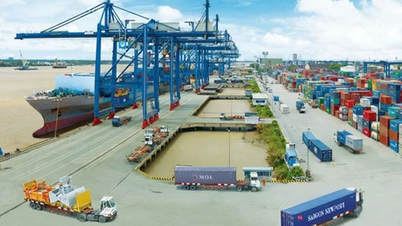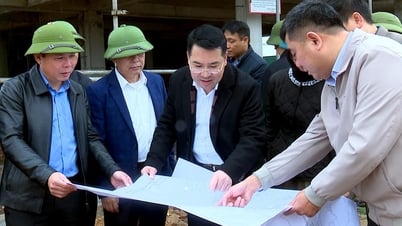Faced with this news, many domestic export enterprises breathed a sigh of relief because they had more time to prepare for the response, while taking advantage of the opportunity to boost exports in the short term. However, 90 days is not too long a time to negotiate a trade policy between two countries.
Therefore, Vietnam needs to urgently dialogue with the US to clarify the bilateral trade interests between the two countries, moving towards creating a long-term framework to promote stable and mutually beneficial economic and trade relations. On the business side, it is necessary to continue to proactively implement solutions to diversify supply sources and markets, minimize risks in the face of unpredictable fluctuations in world trade, and move towards sustainable exports.
Businesses proactively adapt
In 2024, the textile and garment industry will export about 16.6 billion USD to the US, accounting for 38% of the total export turnover of the whole industry and about 15% of the textile and garment import turnover of the US. Vice President of the Vietnam Textile and Apparel Association Truong Van Cam assessed that the negative impact of the US tax policy is large for the Vietnamese economy in general and the textile and garment industry in particular. The profit margin of the textile and garment industry is very thin, not only that, it also has to compete fiercely with goods from many other countries in the US market.
In particular, the reciprocal tax rate applied to Vietnam is much higher than that of other countries, which will greatly reduce the competitiveness of Vietnamese goods, and in the long term, will greatly affect attracting investment in the shortage of supply sources of Vietnamese textiles, such as weaving and dyeing, to meet the rules of origin of free trade agreements (FTAs).
However, in the current context, businesses need to be extremely alert and calm to proactively respond; regularly update the situation, cooperate closely with each other and with buyers to find solutions, share risks and benefits. In addition, businesses need to promote market diversification, especially potential markets - the Vietnamese market has signed FTA, Halal market, South America, etc.
In addition to continuing negotiations with the US on tax policy, Mr. Cam suggested that state management agencies promote negotiations on new FTAs, including the Vietnam-Canada FTA, to be able to stipulate the origin of 2 stages that the Vietnamese and Canadian textile and garment industries are interested in, instead of 3 stages in the CPTPP as at present. All levels and sectors need to share more information about markets, needs, tastes, capacity, ... as well as the ability to cooperate in trade and investment with the Vietnamese garment industry; expand trade connections so that businesses from both sides can meet, exchange, and cooperate.
Domestically, it is necessary to continue reviewing, issuing new policies and maintaining preferential policies on taxes, fees, charges, support for access to loans, interest rate reduction, etc. to support businesses, especially those directly affected, to overcome this difficult period.
Vice President of the Vietnam Timber and Forest Products Association Ngo Sy Hoai informed: The US imposition of tax is a "very strong blow" to the Vietnamese wood industry because this market accounts for 38-40% of the industry's total export turnover with a value of up to 9.4 billion USD. On the contrary, to balance the trade balance, Vietnamese enterprises have increased the import of raw wood from the US to produce tables, chairs, beds and then export them to the US for consumption. Therefore, the impact of this tax is very large, leading to about 4,000 small and medium enterprises that process products for export to the US, along with 1 million farming households, the entire supply chain will certainly be strongly affected.
For a long time, Vietnamese wood industry enterprises have sought to diversify their markets, but it is not easy. Vietnamese wood is currently exported to 161 different markets, but due to its special nature, the wood is very heavy, the quantity of goods in each container is not much, so logistics costs are very high.
Meanwhile, the US has favorable conditions, so our wood industry has long been targeting the US market and placing great expectations on this market. However, in the face of the US's new tariff policy, it is time for the wood industry to restructure its products to maintain the market.
Support businesses to overcome difficulties
Domestic producers account for about 40% of total export turnover of textiles, footwear, wood and wood products. According to Nguyen Thu Oanh, Head of the Service and Price Statistics Department (General Statistics Office, Ministry of Finance), in the short term, domestic producers will have difficulty finding alternative markets, so export turnover of these groups may decline in the coming time due to higher costs and a decrease in the number of orders.
To reduce the negative impact of the US's reciprocal tax policy, Ms. Nguyen Thu Oanh recommended that Vietnam should continue to strengthen bilateral dialogue with the US to clarify the bilateral trade benefits between the two countries, affirming that Vietnam is a fair and trustworthy trade partner; proactively, positively and using many different channels and measures to balance the trade balance between the two countries, especially improving the factors that the US believes Vietnam is protecting and competing unfairly.
Authorities need to proactively provide businesses with information on reciprocal taxes, help businesses prepare data and be ready to respond to protect their interests in the US market; thereby, providing solutions to minimize the impact of tariffs on manufacturers and exporters.
According to economic expert Nguyen Quang Huy, after recent fluctuations in international trade, businesses need to learn the lesson of diversifying export markets, avoiding dependence on one market and adapting to new protectionism.
Vietnamese enterprises need to improve transparency in the production supply chain, origin of goods, labor standards to demonstrate Vietnam's real production capacity; research to shift from low-cost processing to high-value innovation by developing designs, brands, and localizing the value chain. In addition, support from the Government is very important to help enterprises restructure the supply chain, invest in technology, and diversify the market.
In the current difficult context, the Ministry of Industry and Trade recommends that domestic enterprises, in addition to continuing to effectively exploit key and traditional markets, need to develop small and niche markets and open up new potential markets.
Enterprises need to ensure that their exported products meet technical, labor and environmental standards of markets to increase competitiveness and reduce the risk of being subject to trade defense measures; focus on controlling the origin of raw materials for production; and at the same time, raise awareness and ability to respond to trade defense measures from abroad through updating information and participating in related training courses.
Director of Foreign Market Development Department Ta Hoang Linh shared: We have the existing strength of 17 Free Trade Agreements with more than 60 countries and territories; 70 bilateral cooperation mechanisms to promote and expand exports. The US market currently accounts for 13% of global imports, but accounts for 30% of our export turnover. That is an advantage, but also a weakness of Vietnam's exports. The opportunity to exploit the remaining 87% of the world's market is huge. The Ministry of Industry and Trade will promote negotiations of new FTAs with the Middle East, Latin America, Central Asia or other emerging markets; strengthen trade promotion activities; expand the Vietnamese trade office system abroad; improve infrastructure, domestic logistics costs... to pave the way for exports.
(According to NDO)
Source: https://baoyenbai.com.vn/12/348539/Binh-tinh-ung-pho-voi-chinh-sach-thue-cua-My.aspx


![[Photo] Prime Minister Pham Minh Chinh chairs conference on anti-smuggling, trade fraud, and counterfeit goods](https://vphoto.vietnam.vn/thumb/1200x675/vietnam/resource/IMAGE/2025/5/14/6cd67667e99e4248b7d4f587fd21e37c)




















































































Comment (0)